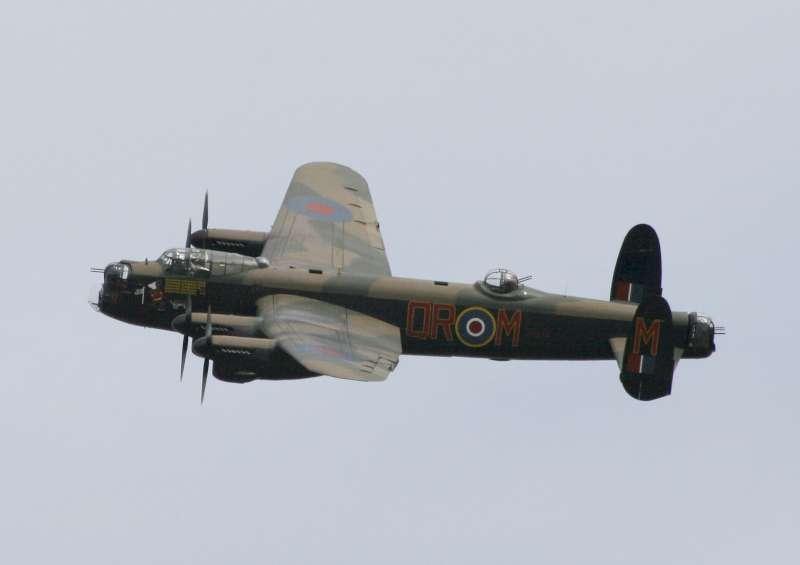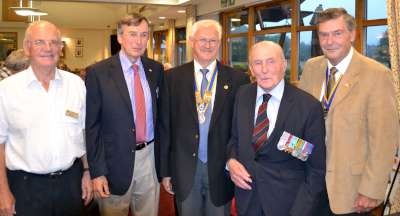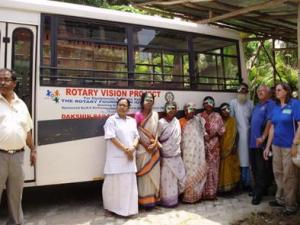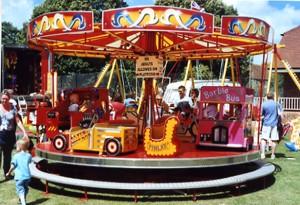'The Dambuster Aircrew' - By the Last survivor
Tue, Jul 14th 2015 at 6:45 pm - 10:00 pm
This talk on the Dambuster Crew and the Bouncing Bomb by. Johnny Johnson, the last surviving Dambuster aircrew who talked to our multi-club event with wives and Rotary business partners

A joint local Rotary Club Meeting held Monday 13th July 2015 at Basingstoke Golf Club with visitors.
Johnny Johnson (94) the last survivor of the Bouncing Bomb Team, gave an exciting and fascinating reminiscence of his service to the country during the second world war years. Later during question time he gave excellent and cogent answers to many questions posed of him. He finally commented on the ultimate futility of war. We were reminded that the average age of the flyers in the raid was about 22 years old, he was 21½ at the time.

Local Presidents with Johnny on the night of our talk. Johnny joined the RAF in Nov 1940 as a very young man. He was selected for flying despite his uncertainty about this idea. He ended up going on a Pilot programme in U.S. Army air training corps in America where he learned a thing or two about the way different troops behaved.
As a failed pilot he nonetheless went on to further training and then to a ship leaving Canada for home to the UK. A quick course request in gunnery led him down a different path. Then on to 'Ops' training unit then sent on as a spare gunner to 97 squadron. They were waiting for Lancasters to be delivered, which finally arrived. They needed a bomb Aimer which offered much better pay, so he thought he would go for that. He was joined by a flt. Lt. Joe Mcarthy and they later became great friends.
Whilst on time away from ops (27/3/42) he got a call to join up with others on a special job. He got married by his commander isnsiting the whole team had time off for the date. Then as part of the 617 squadron he found himself surrounded by a great bunch of experienced people and flyers who joined this team. This was to be the team dealing with the Barnes Wallis bouncing bomb, although they had no idea when they joined, just what they would be in for.
Plenty of low level operation flying at at 100ft. Practice. They had to make their own bomb aiming sights, which they lined up with the target. They used some local dams as practice at Derwent Water.
Later on they had special aircraft delivered to the unit. They had been adapted for new 'dustbin bomb'. At this time they had no news on what the target would be. All flying was practised using no navigation aids only map reading and dead reckoning. This was very difficult when flying over the North Sea twilight excercises, where the sea gave no identifying points of reference.
Nearer the final time when the exercise was to take place, they realised that the event timing depended on fully filled dams and good moonlight to fly by. May was the best time.
Dr Barnes Wallis the designer of the Wellington bomber, demonstrated a film of the bomb. This was under the plane flying at only 60 ft with the bomb rotating backwards at 500 rpm weighing 9000lband containing some 6000lb of explosive.
1943: RAF raid smashes German dams . . . 17th May 1943
Strength 19 Lancaster bombers
Casualties and losses 8 aircraft shot down, 53 aircrew killed, 3 aircrew taken prisoner.
2 dams breached, 1 dam lightly damaged,
approx. 1,600 killed (including 1,000+ prisoners and forced labourers, mainly Soviet)
Finally a detailed meeting with all the high powered staff and ministers present and a good weather forecast ahead. Under the command of Wing Commander Guy Gibson they headed off on an audacious bombing raid into the industrial heartland of Germany and wrecked three dams serving the Ruhr valley. The Möhne Dam and then Eder dam and 5 others went to Zorbe dam which was a different style of Dam required direct drop. Our aircraft had issues and so we had to use spare said Johnny. The compass needed to be 'swung' to compensate for the extra metal with bomb on board. This was recorded on a special card so the pilot could compensate but the card went missing. The pilot had a Parachute problem as it came undone and billowed out whilst crossing the tarmac. All this meant they left 30 mins late. Not an auspicious start.The attack disrupted water and electricity supplies in a key area for the manufacture of Germany's war munitions. The resulting flood waters spread for about 50 miles (80km) from the source.
Johnny's team found the Sorpe dam and seeing a Church steeple they used it to provide a navigation marker. There was no previous training for this bombing raid as it was a different type of Dam. So they had seven dummy runs and on the tenth run they were down to 30' above water. The bomb was eventually let go much to everyone's relief and the 6500lb bomb went off giving they reconed a 1000' water spout in the air. Although expected, no others were about to follow. They flew over the broken Möhne dam on the way home and saw the tremendous devastation and water everywhere. They flew back over the railway marshalling yard which was the main distribution point for German munitions and was an exceptionally dangerous place to pass over.Bullets and flak were in abundance especially flying over the industrial heartland of the German war machine. A puncture to wheel on one plane which was shot through tyre then the wing ended up resting in the fuselage just above the navigators head. A lucky escape.
Others got shot up too. Another crew flew too close to the water and the bouncing bomb was pulled off from the underneath, with the unhappy result that the portable elsan toilet tipped over and the contents were left running round the rear gunner. One flew into a pylon and killed crew. One shot down over coast. Mist stopped another who turned back.But Johnny made it home again. Casualties for the raid were high. Eight of the original 19 Lancaster bombers were damaged or shot down, and of the 133 aircrew, 53 were killed and three captured
Following his talk an auction of a book he authored was sold for £300 raising funds for a favourite charity of Johnny, the Lincolnshire bomber Command trust plus another £400 from the many local Rotary clubs present made a £700 donation from Rotary.
President John Upshall thanked him for his excellent talk and asked everyone present to remember those who gave service and suffered from war and especially the many who lost their lives. The meeting was closed with the Rotary toast 'Rotary and Peace the World Over' our ever hopeful wish.
'What We Do' Main Pages:
Photos and reports of recent events
moreExplore how Rotary can build partnerships with other organisations. We welcome Business and Community Partners who wish to help and support our activities. .
more
Interesting Weekly Talks & Reports. Find out more information about our weekly meeting and talks given to our club.
moreRAISING FUNDS FOR GOOD CAUSES PLEASE HELP US TO HELP OTHERS To make a direct donation or to join our Club Lottery via Basingstoke & Deane Community Lottery please click on Details below
more
Discover more about Rotary International - an interesting and diverse group of professional people working together locally, who dedicate time to various local and international good causes.
moreInformation about Rotary opportunities and support for young people
moreRead here about some of the Club's International Activities
more